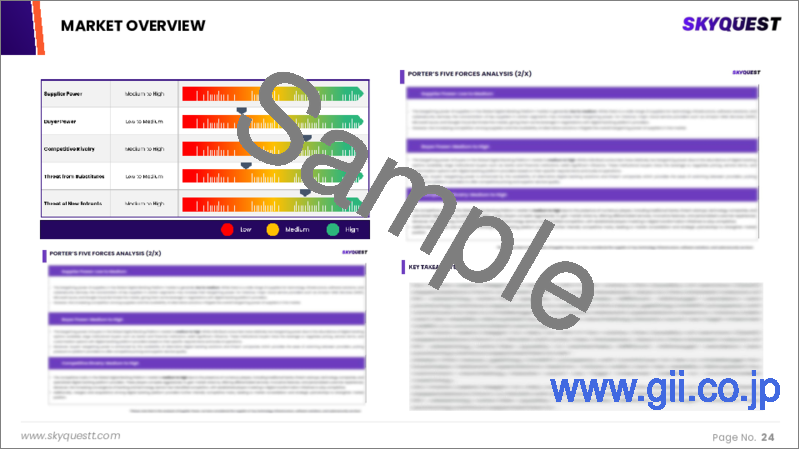|
|
市場調査レポート
商品コード
1646235
プリンターの市場規模、シェア、成長分析:タイプ別、技術別、接続性別、出力別、最終用途別、地域別 - 産業予測 2025~2032年Printer Market Size, Share, Growth Analysis, By Type (Multi-functional Printers, Standalone Printers), By Technology (Dot Matrix, Inkjet), By Connectivity, By Output, By End Use, By Region - Industry Forecast 2025-2032 |
||||||
|
|||||||
| プリンターの市場規模、シェア、成長分析:タイプ別、技術別、接続性別、出力別、最終用途別、地域別 - 産業予測 2025~2032年 |
|
出版日: 2025年01月27日
発行: SkyQuest
ページ情報: 英文 157 Pages
納期: 3~5営業日
|
全表示
- 概要
- 目次
プリンター市場規模は2023年に475億米ドルとなり、2024年の499億2,000万米ドルから2032年には743億2,000万米ドルに成長し、予測期間(2025~2032年)のCAGRは5.1%で成長する見通しです。
世界のプリンター市場は急速に進化しており、USB、Bluetooth、WiFiなど、さまざまな接続オプションを展示しています。2019年だけでも、プリンターやコピー機などのハードコピー周辺機器が世界で9,436万台出荷されており、特に企業分野での需要が旺盛であることを示しています。費用対効果の高い印刷ソリューション、特にドットマトリクス技術の台頭が市場成長を促進すると予想される一方、大判デジタルプリンターは鮮明度と色彩強度を高めた高品質の画像を生成する能力で支持を集めています。こうした進歩にもかかわらず、業界は設備コストの高騰による課題に直面する可能性があり、これが成長見通しを弱める可能性があります。とはいえ、ビジネス、教育、メディアの各分野で多様な用途が広がっていることから、同市場は今後も拡大が見込まれます。
目次
イントロダクション
- 調査の目的
- 調査範囲
- 定義
調査手法
- 情報調達
- 二次データと一次データの方法
- 市場規模予測
- 市場の前提条件と制限
エグゼクティブサマリー
- 世界市場の見通し
- 供給と需要の動向分析
- セグメント別機会分析
市場力学と見通し
- 市場概要
- 市場規模
- 市場力学
- 促進要因と機会
- 抑制要因と課題
- ポーターの分析
主な市場の考察
- 重要成功要因
- 競合の程度
- 主な投資機会
- 市場エコシステム
- 市場の魅力指数(2024年)
- PESTEL分析
- マクロ経済指標
- バリューチェーン分析
- 価格分析
- 技術の進歩
プリンター市場規模:タイプ別
- 市場概要
- 多機能プリンター
- スタンドアロンプリンター
プリンター市場規模:技術別
- 市場概要
- ドットマトリックス
- インクジェット
- LED
- サーマル
- レーザ
- 3D
- その他
プリンター市場規模:接続性別
- 市場概要
- 有線
- 無線
プリンター市場規模:出力別
- 市場概要
- カラープリンター
- モノクロプリンター
プリンター市場規模:最終用途別
- 市場概要
- 工業用
- 住宅用
- 商業用
- 教育機関
- 企業
- 政府
- その他
プリンター市場規模
- 北米
- 米国
- カナダ
- 欧州
- ドイツ
- スペイン
- フランス
- 英国
- イタリア
- その他欧州地域
- アジア太平洋地域
- 中国
- インド
- 日本
- 韓国
- その他アジア太平洋地域
- ラテンアメリカ
- ブラジル
- その他ラテンアメリカ地域
- 中東・アフリカ
- GCC諸国
- 南アフリカ
- その他中東・アフリカ
競合情報
- 上位5社の比較
- 主要企業の市場ポジショニング(2024年)
- 主な市場企業が採用した戦略
- 市場の最近の動向
- 企業の市場シェア分析(2024年)
- 主要企業の企業プロファイル
- 会社概要
- 製品ポートフォリオ分析
- セグメント別シェア分析
- 収益の前年比比較(2022~2024年)
主要企業プロファイル
- HP Inc.(USA)
- Canon Inc.(Japan)
- Seiko Epson Corporation(Japan)
- Brother Industries, Ltd.(Japan)
- Ricoh Company, Ltd.(Japan)
- Konica Minolta, Inc.(Japan)
- Lexmark International, Inc.(USA)
- Kyocera Corporation(Japan)
- Sharp Corporation(Japan)
- Fujifilm Holdings Corporation(Japan)
- Samsung Electronics Co., Ltd.(South Korea)
- Toshiba Tec Corporation(Japan)
- Dell Technologies Inc.(USA)
- Oki Electric Industry Co., Ltd.(Japan)
- Eastman Kodak Company(USA)
- Zebra Technologies Corporation(USA)
- RISO Kagaku Corporation(Japan)
結論と推奨事項
Printer Market size was valued at USD 47.5 billion in 2023 and is poised to grow from USD 49.92 billion in 2024 to USD 74.32 billion by 2032, growing at a CAGR of 5.1% during the forecast period (2025-2032).
The global printer market is evolving rapidly, showcasing a variety of connectivity options, including USB, Bluetooth, WiFi, and more. In 2019 alone, 94.36 million hardcopy peripheral units like printers and copiers were shipped worldwide, signifying robust demand, especially in the corporate sector. The rise of cost-effective printing solutions, particularly dot-matrix technology, is anticipated to propel market growth, while large format digital printers are gaining traction for their ability to produce high-quality images with enhanced sharpness and color intensity. Despite these advancements, the industry may face challenges due to high equipment costs, which could temper growth prospects. Nonetheless, the proliferation of diverse applications across business, education, and media sectors positions the market for continued expansion.
Top-down and bottom-up approaches were used to estimate and validate the size of the Printer market and to estimate the size of various other dependent submarkets. The research methodology used to estimate the market size includes the following details: The key players in the market were identified through secondary research, and their market shares in the respective regions were determined through primary and secondary research. This entire procedure includes the study of the annual and financial reports of the top market players and extensive interviews for key insights from industry leaders such as CEOs, VPs, directors, and marketing executives. All percentage shares split, and breakdowns were determined using secondary sources and verified through Primary sources. All possible parameters that affect the markets covered in this research study have been accounted for, viewed in extensive detail, verified through primary research, and analyzed to get the final quantitative and qualitative data.
Printer Market Segments Analysis
Global Printer Market is segmented by Type, Technology, Connectivity, Output, End Use and region. Based on Type, the market is segmented into Multi-functional Printers and Standalone Printers. Based on Technology, the market is segmented into Dot Matrix, Inkjet, LED, Thermal, Laser, 3D and Others. Based on Connectivity, the market is segmented into Wired and Wireless. Based on Output, the market is segmented into Color Printers and Monochrome Printers. Based on End Use, the market is segmented into Industrial, Residential and Commercial. Based on region, the market is segmented into North America, Europe, Asia Pacific, Latin America and Middle East & Africa.
Driver of the Printer Market
The global printer market is significantly driven by the rising demand from small and medium-sized enterprises (SMEs) across the globe. SMEs are crucial contributors to national GDPs and serve as a primary source of employment in countries such as India, China, Germany, and the UK, thereby playing a pivotal role in economic development. These businesses rely heavily on printers for a variety of documents, including invoices, marketing materials, and internal communications, making printers essential office tools. Unlike large corporations, SMEs have unique printing requirements and often focus on multifunctional printing devices that can fulfill diverse operational needs while being cost-effective.
Restraints in the Printer Market
The global printer market faces significant constraints due to the ongoing digitization of businesses. Companies are increasingly turning to online platforms for sharing information and promoting their products, opting for digital formats over traditional printed materials. This shift includes the use of e-brochures, e-catalogs, e-annual reports, and e-manuals, reflecting changing consumer preferences. The rise of the internet, along with widespread smartphone adoption and improved communication infrastructure, has accelerated this transition. Additionally, the popularity of cloud-based storage solutions like Dropbox and Google Drive has further diminished the reliance on printed documents, ultimately hindering the growth potential of the global printer market.
Market Trends of the Printer Market
The printer market is witnessing a significant trend towards multifunctional printers (MFPs), driven by a growing consumer preference for energy-efficient, integrated solutions over traditional standalone printers. As businesses prioritize sustainability, MFPs have become essential in implementing effective print management strategies that not only reduce energy consumption but also streamline print, copy, and mail operations. Key players like Ricoh, HP, Canon, and Epson are investing heavily in research and development to innovate their product lines; for instance, Ricoh's introduction of the IM series and Epson's WF-M21000, both released recently, highlight advancements in speed and functionality. Furthermore, MFPs enhance security, providing easier management for IT departments compared to traditional printers, making them an attractive option for organizations focused on efficiency and protection.
Table of Contents
Introduction
- Objectives of the Study
- Scope of the Report
- Definitions
Research Methodology
- Information Procurement
- Secondary & Primary Data Methods
- Market Size Estimation
- Market Assumptions & Limitations
Executive Summary
- Global Market Outlook
- Supply & Demand Trend Analysis
- Segmental Opportunity Analysis
Market Dynamics & Outlook
- Market Overview
- Market Size
- Market Dynamics
- Drivers & Opportunities
- Restraints & Challenges
- Porters Analysis
- Competitive rivalry
- Threat of substitute
- Bargaining power of buyers
- Threat of new entrants
- Bargaining power of suppliers
Key Market Insights
- Key Success Factors
- Degree of Competition
- Top Investment Pockets
- Market Ecosystem
- Market Attractiveness Index, 2024
- PESTEL Analysis
- Macro-Economic Indicators
- Value Chain Analysis
- Pricing Analysis
- Technological Advancement
Global Printer Market Size by Type & CAGR (2025-2032)
- Market Overview
- Multi-functional Printers
- Standalone Printers
Global Printer Market Size by Technology & CAGR (2025-2032)
- Market Overview
- Dot Matrix
- Inkjet
- LED
- Thermal
- Laser
- 3D
- Others
Global Printer Market Size by Connectivity & CAGR (2025-2032)
- Market Overview
- Wired
- Wireless
Global Printer Market Size by Output & CAGR (2025-2032)
- Market Overview
- Color Printers
- Monochrome Printers
Global Printer Market Size by End Use & CAGR (2025-2032)
- Market Overview
- Industrial
- Residential
- Commercial
- Educational Institutions
- Enterprises
- Government
- Others
Global Printer Market Size & CAGR (2025-2032)
- North America (Type, Technology, Connectivity, Output, End Use)
- US
- Canada
- Europe (Type, Technology, Connectivity, Output, End Use)
- Germany
- Spain
- France
- UK
- Italy
- Rest of Europe
- Asia Pacific (Type, Technology, Connectivity, Output, End Use)
- China
- India
- Japan
- South Korea
- Rest of Asia-Pacific
- Latin America (Type, Technology, Connectivity, Output, End Use)
- Brazil
- Rest of Latin America
- Middle East & Africa (Type, Technology, Connectivity, Output, End Use)
- GCC Countries
- South Africa
- Rest of Middle East & Africa
Competitive Intelligence
- Top 5 Player Comparison
- Market Positioning of Key Players, 2024
- Strategies Adopted by Key Market Players
- Recent Developments in the Market
- Company Market Share Analysis, 2024
- Company Profiles of All Key Players
- Company Details
- Product Portfolio Analysis
- Company's Segmental Share Analysis
- Revenue Y-O-Y Comparison (2022-2024)
Key Company Profiles
- HP Inc. (USA)
- Company Overview
- Business Segment Overview
- Financial Updates
- Key Developments
- Canon Inc. (Japan)
- Company Overview
- Business Segment Overview
- Financial Updates
- Key Developments
- Seiko Epson Corporation (Japan)
- Company Overview
- Business Segment Overview
- Financial Updates
- Key Developments
- Brother Industries, Ltd. (Japan)
- Company Overview
- Business Segment Overview
- Financial Updates
- Key Developments
- Ricoh Company, Ltd. (Japan)
- Company Overview
- Business Segment Overview
- Financial Updates
- Key Developments
- Konica Minolta, Inc. (Japan)
- Company Overview
- Business Segment Overview
- Financial Updates
- Key Developments
- Lexmark International, Inc. (USA)
- Company Overview
- Business Segment Overview
- Financial Updates
- Key Developments
- Kyocera Corporation (Japan)
- Company Overview
- Business Segment Overview
- Financial Updates
- Key Developments
- Sharp Corporation (Japan)
- Company Overview
- Business Segment Overview
- Financial Updates
- Key Developments
- Fujifilm Holdings Corporation (Japan)
- Company Overview
- Business Segment Overview
- Financial Updates
- Key Developments
- Samsung Electronics Co., Ltd. (South Korea)
- Company Overview
- Business Segment Overview
- Financial Updates
- Key Developments
- Toshiba Tec Corporation (Japan)
- Company Overview
- Business Segment Overview
- Financial Updates
- Key Developments
- Dell Technologies Inc. (USA)
- Company Overview
- Business Segment Overview
- Financial Updates
- Key Developments
- Oki Electric Industry Co., Ltd. (Japan)
- Company Overview
- Business Segment Overview
- Financial Updates
- Key Developments
- Eastman Kodak Company (USA)
- Company Overview
- Business Segment Overview
- Financial Updates
- Key Developments
- Zebra Technologies Corporation (USA)
- Company Overview
- Business Segment Overview
- Financial Updates
- Key Developments
- RISO Kagaku Corporation (Japan)
- Company Overview
- Business Segment Overview
- Financial Updates
- Key Developments





